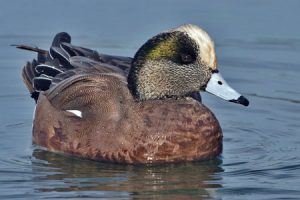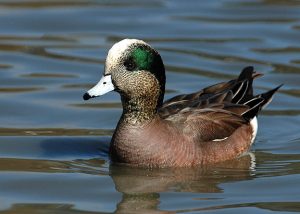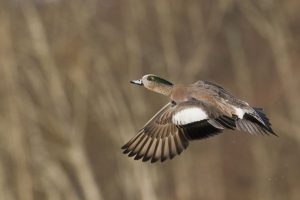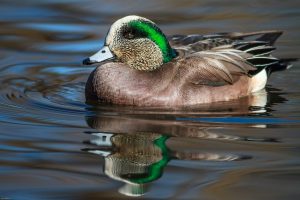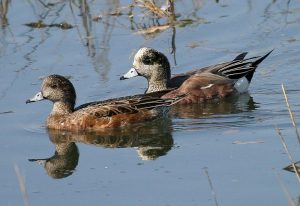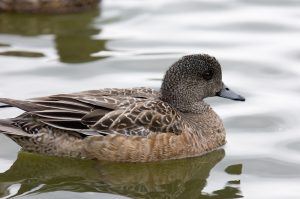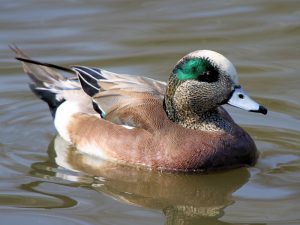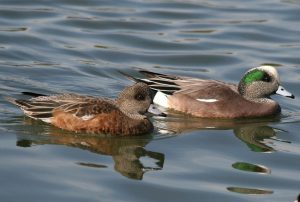American Wigeon
American wigeons are dabbling ducks found in the Americas. They belong to the same family as the gadwall, falcated teal, Chiloe wigeon, and Eurasian wigeon.
Scientific Classification
| Kingdom | Animalia |
| Phylum | Chordata |
| Class | Aves |
| Order | Anseriformes |
| Family | Anatidae |
| Genus | Mareca |
| Scientific Name | Mareca Americana |
Quick Information
| Also known as | Baldpate |
| Description | Size: These ducks are 17-23 in (42-59 cm) long Wingspan: Their unfurled wings measure at around 30-36 in (76-91 cm) from tip to tip Weight: They weigh 1.1-3 lb (0.5-1.33 kg) Color: Breeding males have a white cap, a grayish brown head, and a wide green patch behind the eyes, their bellies are white, females have brown and grey plumage; non-breeding males look like the females; the bills of both genders are pale blue; there is a grey-colored wing patch behind the speculum |
| Distribution | Northwestern to central North America as far south as northeastern California and northern Colorado; migrates to northern South America, Hawaii, and the West Indies; vagrant populations have been seen in western Europe |
| Habitat | They inhabit freshwater lakes, wetlands, estuaries, marshes, slow-moving rivers, flooded fields, and reservoirs |
| Sounds & Communication | Males (drakes) have a high-pitched, squeaky toy-like three-note call (whoee-whoe-whoe), while hens produce rough quacks and grunts (qua-ack) |
| Lifespan | They live for around 2 years in the wild |
| Diet | The main diet for these birds is plant material, both terrestrial and aquatic; may also feed on crustaceans, mollusks, and insects |
| Adaptations | The short, stout bill helps it to pull off leaves and stems from plants more easily |
| Predators | They may be preyed on by American crows, northern harriers, California gulls, red foxes, striped skunks, Franklin’s ground squirrels, short-tailed weasels, and American badgers |
| IUCN Conservation Status | Least Concern |
Behavior
- These birds are sometimes called robber or poacher ducks as they snatch food from diving birds like coots, canvasbacks, and redheads, as they bring plant material up to the surface of the water.
- They are highly social and stay in large flocks at all times except the breeding season, during which they tend to become territorial.
- American wigeons are as comfortable on land as they are on the water.
- They are a cautious bird, known to take to the skies in an erratic flight at the slightest hint of trouble.
Mating & Reproduction
The breeding season for these ducks is in spring. Males compete for females by putting on displays and posturing threateningly to rivals. Pairs form in the wintering grounds. The female makes a nest on the ground in the vicinity of water bodies. A clutch of 3-13 eggs is laid and incubated only by the female for around 23-25 days.
Life-cycle
The young are relatively mature at hatching, being able to leave the nest and feed themselves in a short amount of time. They become capable of flying after around 45-63 days. Both males and females become sexually mature at approximately 1 year of age.
Interesting Facts
- The oldest recorded American wigeon lived for 21 years and 4 months.
- Their alternative name, ‘baldpate,’ comes from the white patch of skin that the male has during the breeding season.
References:
- https://www.borealbirds.org/bird/american-wigeon
- http://www.nhptv.org/wild/americanwigeon.asp
- https://www.iucnredlist.org/species/22680163/137010293
- https://birdsoftheworld.org/bow/species/amewig/cur/introduction
- https://www.allaboutbirds.org/guide/American_Wigeon/overview
- https://www.audubon.org/field-guide/bird/american-wigeon
- https://animaldiversity.org/accounts/Anas_americana/
Published on May 18th 2018 by Sudipto Chakrabarti under Coniferous Forest Animals.
Article was last reviewed on 17th July 2023.


